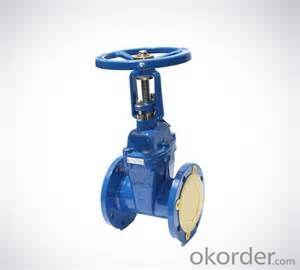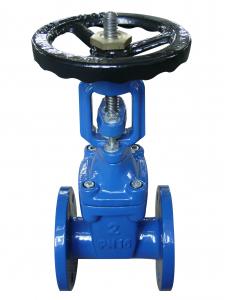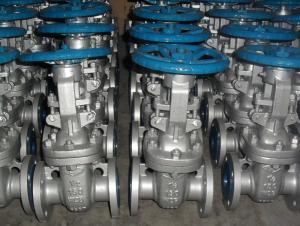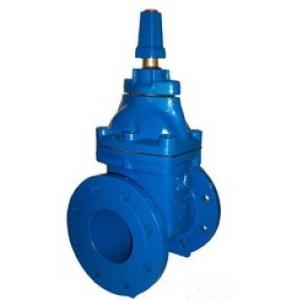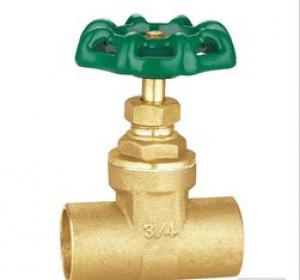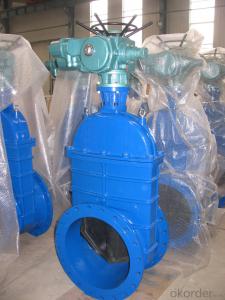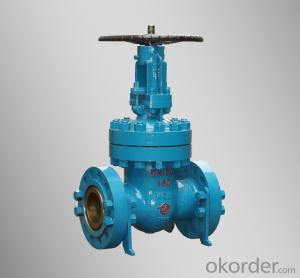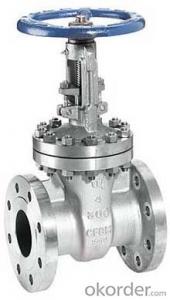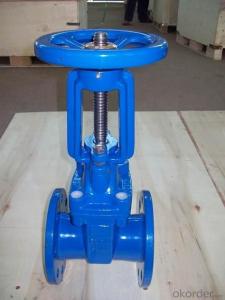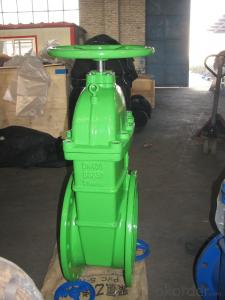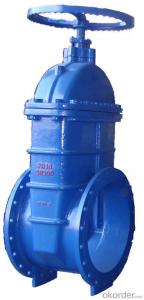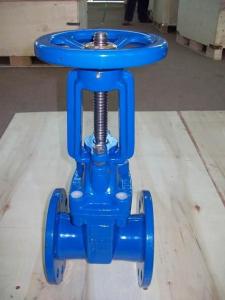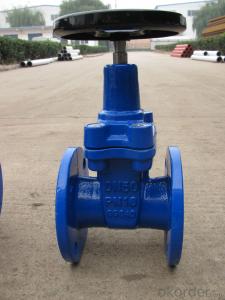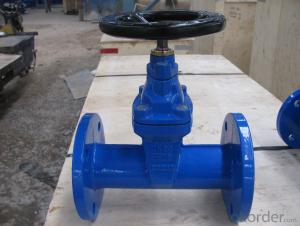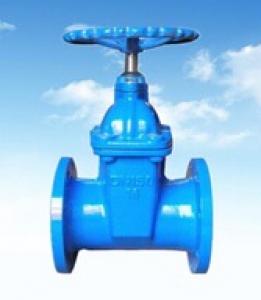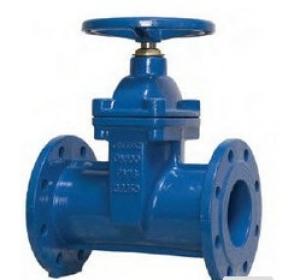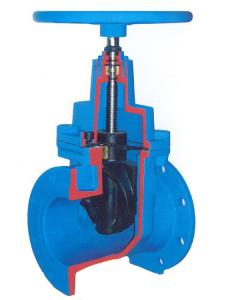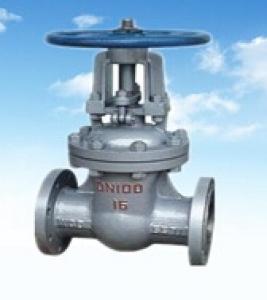Gate Valve BS Resilient Seated gate valve, PN16 Rising Stem
- Loading Port:
- Tianjin
- Payment Terms:
- TT OR LC
- Min Order Qty:
- 200 kg
- Supply Capability:
- 10000 kg/month
OKorder Service Pledge
OKorder Financial Service
You Might Also Like
1.Structure of Gate Valve Description:
A gate valve, also known as a sluice valve, is a valve that opens by lifting a round or rectangular gate/wedge out of the path of the fluid. The distinct feature of a gate valve is the sealing surfaces between the gate and seats are planar, so gate valves are often used when a straight-line flow of fluid and minimum restriction is desired. The gate faces can form a wedge shape or they can be parallel. Gate valves are primarily used to permit or prevent the flow of liquids, but typical gate valves shouldn't be used for regulating flow, unless they are specifically designed for that purpose. Because of their ability to cut through liquids, gate valves are often used in the petroleum industry. For extremely thick fluids, a specialty valve often known as a knife valve is used to cut through the liquid. On opening the gate valve, the flow path is enlarged in a highly nonlinear manner with respect to percent of opening. This means that flow rate does not change evenly with stem travel. Also, a partially open gate disk tends to vibrate from the fluid flow. Most of the flow change occurs near shutoff with a relatively high fluid velocity causing disk and seat wear and eventual leakage if used to regulate flow. Typical gate valves are designed to be fully opened or closed.When fully open, the typical gate valve has no obstruction in the flow path, resulting in very low friction loss.
2. Main Features of the Gate Valve:
• Valve body cavity using non-toxic epoxy resin,both inside and outside flashboard completely is coated with rubber
• Free of water pollution
• High manufacturing accuracy
• High strength
• Environmental protection and energy saving
• Good visual effect
3. Images

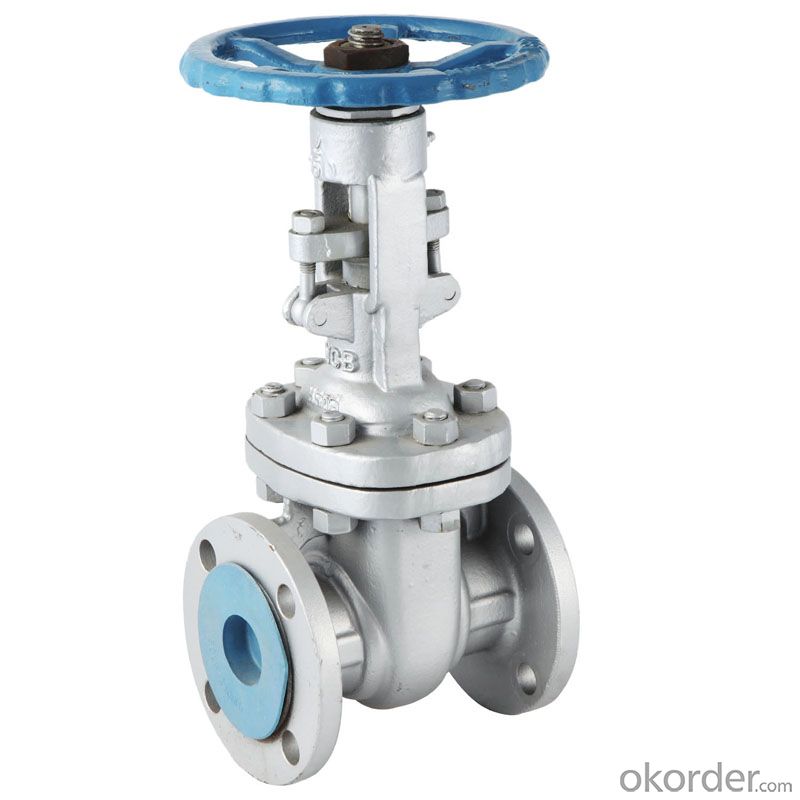
4. Gate valve Specification
1) Size: DN15 - 1, 000mm;
2) Class: PN1.0 - 16.0Mpa;
3) Material: WCB,WCC,WC6,WC9,304,316,CF8,CF3,CF8M,CF3M 4) Standards: API600 API602 API603 API6D
A) Design and manufacture: DIN3352;
B) Face to face dimensions: DIN3202;
C) End flange dimensions: DIN2543-2551;
D) Inspection and test DIN3230.
5.FAQ
1. What's are the characteristics of gate valve?
The distinct feature of a gate valve is the sealing surfaces between the gate and seats are planar, so gate valves are often used when a straight-line flow of fluid and minimum restriction is desired. The gate faces can form a wedge shape or they can be parallel.
2. What is the work principle of gate valve ?
The gate faces can form a wedge shape or they can be parallel. Gate valves are primarily used to permit or prevent the flow of liquids, but typical gate valves shouldn't be used for regulating flow, unless they are specifically designed for that purpose. Because of their ability to cut through liquids, gate valves are often used in the petroleum industry.
3. What is the structure?
Bonnets provide leakproof closure for the valve body. Gate valves may have a screw-in, union, or bolted bonnet. Screw-in bonnet is the simplest, offering a durable, pressure-tight seal. Union bonnet is suitable for applications requiring frequent inspection and cleaning. It also gives the body added strength. Bolted bonnet is used for larger valves and higher pressure applications.
- Q: Gate valve, butterfly valve, ball valve advantages and disadvantages? What are the usual valves?
- Commonly used valves are: gate valve, globe valve, check valve, ball valve, butterfly valve, safety valve, regulating valve, plug valve and so onValve: valve is closed parts (RAM) vertical movement of the valve in the pipeline along the channel axis, used primarily as a medium cut that open and close use. In general, the valve can not be used as a regulation flow. The utility model can be applied to low temperature pressure, and can also be applied to high temperature and high pressure, and can be made according to different materials of the valve. But the valve is generally not used to transport mud and other media pipeline.Advantages: fluid resistance is small; the opening and closing torque needed by the smaller; can use the ring pipe flow to the two direction in the medium, that is to say the unrestricted flow of medium; the fully open, the sealing surface by the erosion of the working medium is smaller than the cut-off valve; the body has the advantages of simple structure, manufacturing good craft; the structure of relatively short length.Disadvantages: the size and height on the larger required installation space is larger; in the process of opening and closing, a relative friction sealing, friction is large, even scratch phenomenon caused by easily at high temperature; the valve has two sealing surface, to processing, polishing and maintenance of some increase the opening and closing time difficult.
- Q: How about the model of stainless steel gate valve?
- Stainless steel gate valve is divided into 304 stainless steel gate valve, 316 stainless steel gate valve, 321 stainless steel gate valve. The expression is: Z41H-16P.
- Q: What is the standard for ductile iron gate valve set?
- Clear shot valve installation, is still under way of connection and specifications set "water supply and drainage, heating, gas engineering" or "industrial engineering" pipeline register quota corresponding specifications and installation methods of connecting the valve installed valve section.
- Q: Gate valve z45h-10dn250 length of the body?
- Z45h-10dn250 body length L=330mm, this valve is hidden bar, elastic seat, sealing gate valve, gate lining, lining fluorine, belong to soft seal
- Q: Stainless steel gate valve DN150 200300 weight, who knows?
- It depends on different materials and pressure levels. 304 material, high pressure weight will be much heavier.
- Q: What does the gate valve SZ45X-1.0 stand for?
- Z- stands for gate valves, 4 for flange connections, 5 for wedge wedge single gate, X for rubber seals, and 1.0- for PN1.0MP
- Q: What's the meaning of the gate valve model z41x 16Q?
- According to the provisions of the JB/T 308-2004 valve type programming method:Z = gate valve4 = flange connection1 = structural form: wedge type single gateX = sealing surface material: Rubber16== pressure rating: 1.6MPaQ== body material: ductile iron
- Q: Gate valve is gate valve, gate valve specifications, model code is generally what?
- Gate valve is not gate valve, gate valve does not have a fixed specific model
- Q: What is plug welding gate valve?
- Plug connection pipeline welding mode safety gate valve
- Q: What is the difference between gate valve 41h-16c and 41w-16p?
- The difference between 41h-16c and 41w-16p is that the material of the valve body and the material of the sealing surface are different.According to the provisions of the JB/T 308-2004 valve type programming method:H== sealing surface material: Cr13 stainless steelC== body material: carbon steelW== sealing surface material: body, that is, with the same material bodyP== body material: chrome nickel stainless steel
Send your message to us
Gate Valve BS Resilient Seated gate valve, PN16 Rising Stem
- Loading Port:
- Tianjin
- Payment Terms:
- TT OR LC
- Min Order Qty:
- 200 kg
- Supply Capability:
- 10000 kg/month
OKorder Service Pledge
OKorder Financial Service
Similar products
Hot products
Hot Searches
Related keywords
